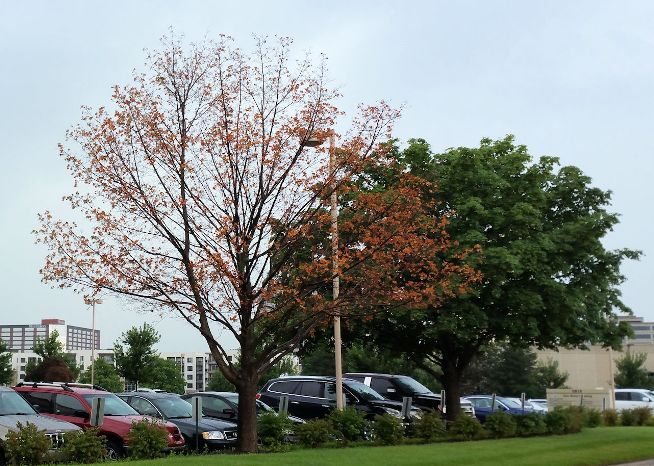
Being an arborist is a lot like being a good detective. You get a call saying there is a problem with a tree. You ask the client questions to gather facts about the tree’s history. Then you go to the site and look for clues to the problem and ask more questions if needed. Sometimes the situation is obvious and other times it can be a real challenge, but most tree problems will fall into three categories: insect, disease, or environment. In many cases, it is a combination.
As you have heard many times before, healthy plants are more resistant to insects and disease, but what about environmental stresses? Even the healthiest plant can’t guard against weed whackers or backhoes trenching through its root system. Nine times out of ten, it is an environmental stress that leads to the insect or disease attacking the plant. This is what confuses many homeowners. For example, they see leaf scorch and want to spray it to solve the problem. However, the leaf scorch can merely be a symptom, not the main problem. Both the weed trimmer and backhoe stress examples above could cause leaf scorch or leaves to drop, but they are two very different problems that spraying would have no effect on.
You must find signs to diagnose a problem and treat it correctly; symptoms only let us know that there is a problem. A chewed leaf is a symptom unless the feeding pattern is unique to a certain type of insect; then it is a sign. A birch tree dying at the top is a symptom, but the D-shaped exit hole on the trunk is a sign that borers are present.
Now you can begin to understand how many times diseases and insects are only the symptoms of the environmental stresses that are the real problem. Too often only the symptoms are treated, without addressing the real issues that are causing the problem. A good example is leaf miner on birch trees. If you keep the tree well-watered, mulch around the root zone, avoid planting it on a berm or top of a hill, and fertilize it once a year, it will stay healthy for a long time. On the other hand, plant it in the wrong place, don’t water, mulch, or fertilize it, and you will spend quite a bit of money each spring spraying to keep it healthy.
Unfortunately, what happens too often is that the obvious problem gets treated without the root cause being addressed, which can lead to unnecessary expense and use of pesticides.
Environmental stresses are very common, but can be difficult to identify. They include drought stress, improper pH of soil, girdling roots, salt build-up in the soil, lightning strikes, herbicide damage, root confinement, bad drainage, compacted soils, improper planting, change of grade, root disturbance, and many more. Some can be corrected and some cannot. It helps to know what you’re up against before you decide a course of action and whether to treat just the symptoms or try to fix the real cause.
Treatments for Stressed Plants
The good news is that today we have more options than ever in treating stressed plants. Not too long ago, tree care consisted of spraying everything three times a year, whether it needed it or not, and fertilizing in the fall. This hit or miss approach has become outdated and even irresponsible. As the public awareness of pesticides has grown, so has the demand for safer and more environmentally sound treatments. In recent years, science has developed more biological controls than ever before. Products such as Bt, which controls caterpillars by infecting them with a virus, are becoming the preferred choice as opposed to broad-spectrum insecticides that kill both good and bad insects.
Recently a nematode was introduced that will attack grubs and termites in the soil without affecting earthworms and other beneficial insects. They will live in the soil for years with only a single application and eliminate the need for multiple applications of pesticides on lawns, reducing the risks to both children and animals. Another product is a fungus that is antagonistic to the Dutch elm disease fungus. It has shown much promise and could mean the return of the beautiful elms that once lined so many of our streets.
Mycorrhiza use has grown by leaps and bounds in recent years as arborists have discovered the many benefits they provide to our urban trees. This beneficial fungus attaches itself to the roots of plants and creates a second root system that is much more efficient at absorbing water and nutrients for the plant. It also guards against harmful soil borne pathogens that otherwise could attack the plant. It will also increase drought and salt tolerances, increase fruiting and flowering in many plants, and reduce transplant shock. Mycorrhizae have been around for millions of years working in a symbiotic relationship with plants in forests and meadows, but in our urban landscape they have been reduced by many common cultural practices. By reintroducing them to our urban trees, we help reestablish this natural, beneficial relationship.
Steve Turner, Certified Arborist, is from Arboricultural Services in Fenton, MI. He can be contacted at wecarefortrees@gmail.com.
Related Articles
Five Ways to Make Help Nature Make Topsoil
Proper Mulching is One of the Best Things You Can do for Your Plants




Comment here